If you’re looking to rebrand your business or redesign your logo, this article explores the rebranding trends to know and the rules to follow for a successful rebrand.

If you’re looking to rebrand your business or redesign your logo, this article explores the rebranding trends to know in 2019 and the rules to follow for a successful rebrand. Read on to learn about the cost of rebranding and which brands get it right.
No talk of successful rebranding is complete without mentioning the now legendary transformation of Federal Express in 1994.
Fred Smith, its founder, chairman, and CEO, wanted to reinvigorate the company’s image. He challenged the creative team to make the Federal Express truck recognizable from five blocks away.
The result: a shortened name—FedEx—and a bold, zippy new logo:
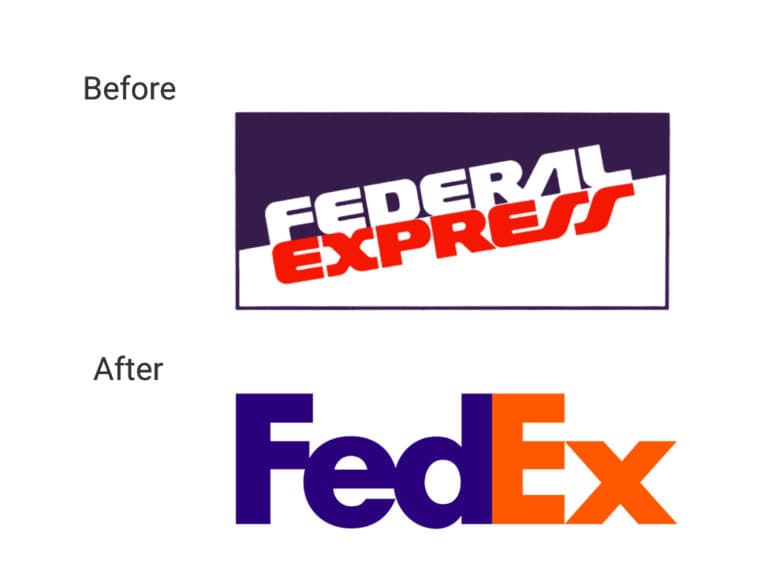
The new name and visual identity perfectly encapsulated the company’s value proposition: speed. Notice the hidden arrow in what looks like a simple wordmark?
The new branding catapulted FedEx into the next century and remains relevant and powerful even today.
But rebranding doesn’t always turn out the way it did for FedEx.
Take the case of Tropicana’s rebranded packaging in 2009.
What was supposed to make their brand more current and fresh soon became stale? Sales dove 20%—equivalent to $137 million—in the first six weeks after Tropicana unveiled its new look.
Cutting its losses, the company reverted to its old packaging, which is still in use as of this writing.
What makes the difference between a rebranding triumph and a fiasco?
We’ll explore some possible answers in this post.
The Cost of Rebranding
Rebranding entails huge costs and risks. Companies hire branding experts to conceptualize the rebrand. And then, other consultants and vendors are needed to roll out the new identity.
After studying over 1,200 rebranding projects spanning 25 years, the VIM Group estimates that the cost of implementing a rebrand is 20 times the cost of developing the new brand identity.
In other words, for every dollar a company pays branding and design consultants to come up with the brand redesign, it will spend $20 to roll it out.
Not to mention the time the entire exercise takes and the potential loss of goodwill, reputation, and sales, should the new branding flop.
Yet, for all its costs and risks, rebranding is surprisingly common. In the hospitality industry, for example, researchers have found that one-third of all hotel properties have changed brands since opening. And companies that have been around for decades have iterated their identities several times throughout the years.
Why do businesses make this terrifying leap? There are plenty of good reasons to do so.
Why Rebrand a Business?
Whether internal to the business or coming from the environment, a number of factors may demand a rebrand.
01. Reflect The Company’s New Positioning
Like humans, companies change over time, and, when it does, a brand redesign becomes necessary. It’s like when children grow up into adults. They drop the silly nicknames and need a whole new wardrobe. A variety of situations may account for this:
- The company has evolved. It has shifted to a different market, product offering, or value proposition altogether.

- The market has evolved. A business may need a new identity to respond to consumer demands and expectations.
Case in Point: Mailchimp makes room for customer-driven growth while refusing to grow up.
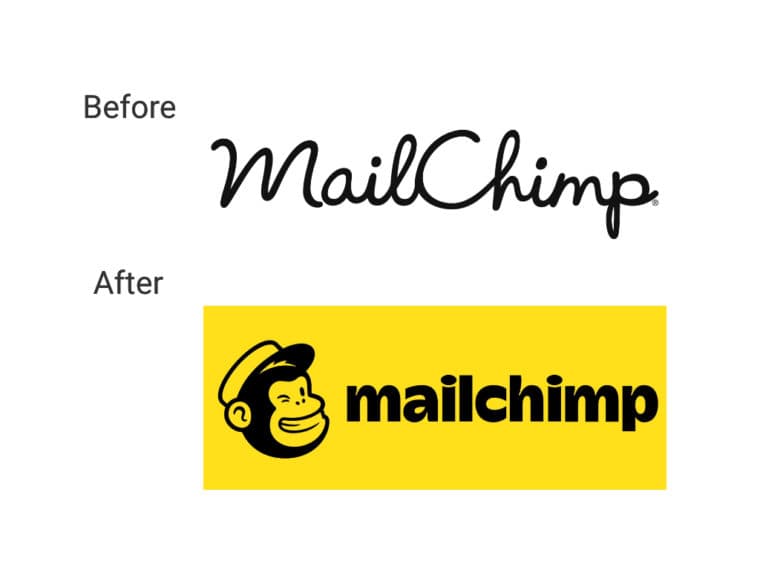
- Technological advances. The emergence of new technologies can make a company’s positioning—sometimes even the company itself—obsolete.
Case in Point: Squarespace embraces a new brand that “makes sense in motion.”
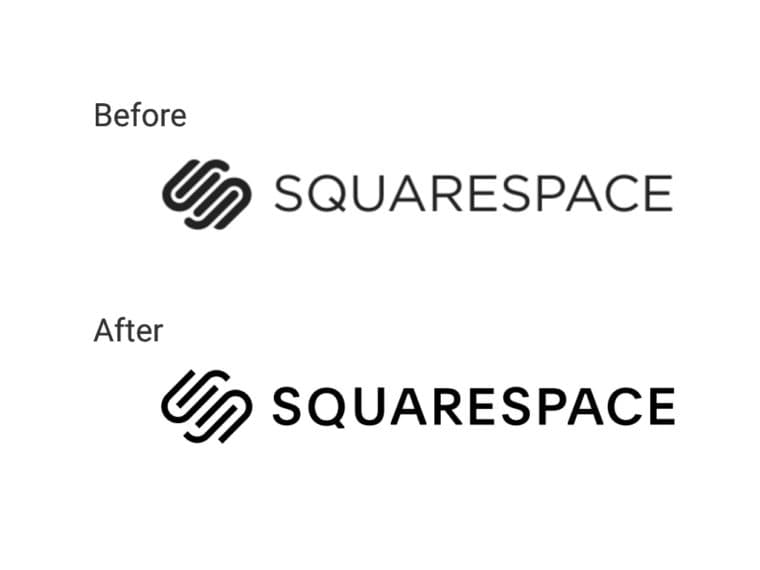
- Differentiation. As the market evolves and new players arrive, the company may need to reinvent itself to differentiate from the competition.
- Internationalization. Entering a new country may compel a business to rebrand in order to better align culturally with the new market.
- Negative image. A PR crisis, negative reactions from stakeholders, and other manifestations of a poor reputation could compel a massive identity makeover.
02. Make The Branding More Relevant
One of the most common reasons to rebrand is to keep current and cutting-edge. It’s like throwing out your grandma’s bell bottoms and replacing them with bootcut pants.
Several situations may warrant a brand refresh:
- An outdated brand. As with fashion, branding trends come and go. When a company’s brand looks old-fashioned and tired, then it needs sprucing up.
Case in Point: Bhutan gets a modern look for today’s marketplace.

- Misaligned brand expressions. Through the years, an organization’s brand expressions may have gotten scattered and inconsistent. Their website has one look, and their product packaging has another. A branding makeover may be called for to make everything look not just fresh but cohesive.
Case in Point: Slack gets its visual act together with a logo redesign.
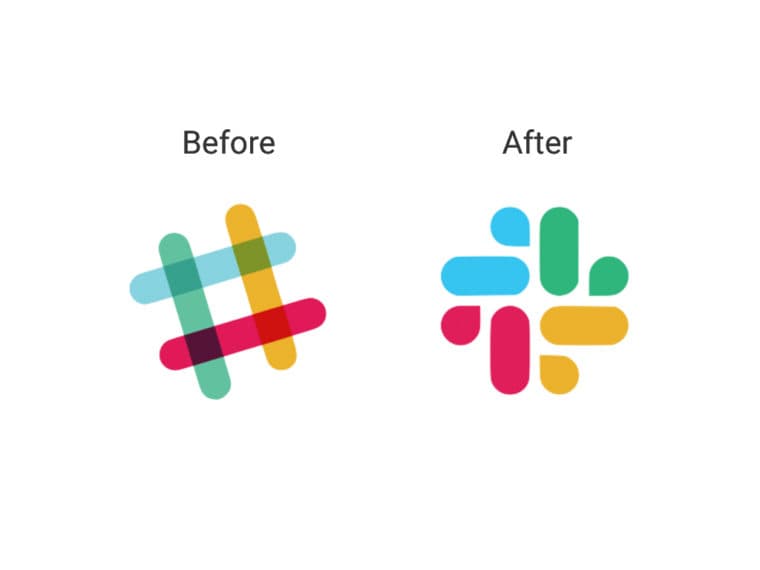
- Branding reset. The original branding wasn’t well-thought-out in the first place, because the founder needed a brand name and logo quickly, not realizing how fast the business would grow. Now that they have the resources, they want to do branding correctly and drop the one that just happened to be the most convenient at the time.
03. Change in Business Ownership
Structural changes in a company arising from mergers, demergers, acquisitions, joint ventures, and spin-offs often require rebranding.
Rebranding may be part and parcel of the deal. Or, it may be the logical thing to do after the ownership change takes place. Mergers may mean a literal merging of business names, for example. And acquisitions may wipe out one company’s identity altogether.
Case in Point: Hewlett Packard Enterprise brands itself as “The Machine” to launch its demerger from Hewlett Packard.

04. Meet Legal Requirements
The courts may require a company to change its name and/or visual branding if these are deemed to infringe on the copyright of another company. This happens when the branding is too similar to one that’s protected by law.
05. Change in Leadership
The arrival of a new CEO does not always require rebranding. But if the CEO is prominent and likely to stay on for many years, then rebranding may be a good way to reflect the company’s change in direction and vision.
An example that comes to mind is the rebranding of Apple when Steve Jobs returned as CEO in 1997. However, Jobs’ return to Apple also meant restructuring the company. And so, the rebranding was more a reflection of substantial changes than simply the return of its original founder.
Types of Rebranding
Rebranding takes different shapes and forms, depending on its scale and scope, which are dictated by the reason for rebranding.
- Visual Only
Rebranding may be a simple matter of a logo redesign, a font style change, or new colors. Freshening up an established brand or adapting the logo to digital media may require little more than a visual identity change. - Renaming + Visual
More significant rebranding involves changing the name as well as the visual identity of a business. Ownership changes, restructuring, market evolution, and legal requirements are some of the drivers of a rebranding with this scope. - The Works
When the very essence of a business changes, then the brand redesign goes beyond skin-deep as well. Rebranding begins from the core of the business—its vision, mission, and values—and radiates to its outward expressions.
Rebranding Trends 2019
Just as there are trends in fashion, there are trends in rebranding as well. Here are the top rebranding trends we’ve noticed:
01. Brand Simplification
Companies seeking to refresh their identities are opting to make their visuals clean and uncluttered. This may be because minimalist designs look best on digital media, particularly on mobile devices.
Minimalist designs are characterized by the use of white or negative space, sans serif fonts, and flat—not 3-dimensional—forms (although depth may be going back in style again soon).
In terms of names, simplification means short and punchy monikers, as in the case of FedEx. Mastercard seems to be aiming for simplicity with its logo redesign:

02. Un-branding, Reverse-Branding, or Debranding
Millennials become loyal to brands, not because of their image, but because of what they stand for. And so, they reject visual gimmickry (traditional logos, fonts, colors, and imagery) and instead look at a brand’s authenticity, values, and integrity.
In response, companies are adopting styles that may appear like the absence of branding: nondescript, generic, bland, even. Skincare brand, The Ordinary, exemplifies un-branding from its name to its visual design:

03. Throwback/Vintage Branding
Rather than putting on modern appearances, some brands are donning vintage looks. Trend curator Rohit Bhargava calls it “RetroTrust.”
Often unsure of whom to trust, consumers look back to organizations and experiences with brands that have a legacy, or those with which they have a personal history
Bhargava writes in Non-Obvious 2019: How to Predict Trends and Win the Future.
“”
This may seem to contradict the need to modernize and keep up with the times. In fact, it’s the pendulum swinging in the opposite direction.
Many have become disillusioned with over-digitization, with its lack of personalization, unrelenting pace, and abstraction. They’re harking back to the “good ol’ days.” Hence, the return of vinyl records, retro gaming, and even the Ektachrome film.
Whistler Classic Soda’s retro logo embodies its 1950s origins:

5 Key Ingredients of Successful Rebranding
What can we learn from the experience of companies that have rebranded?
Success is never guaranteed, that’s for sure, but rebranding best practices helps increase the chances of a positive outcome, such as:
01. Do it for the Right Reasons
With the costs and risks inherent in rebranding, you better be doing it for the right reasons. Needing a fresher look, for example, is not always a good reason to rebrand.
Change for the sake of change can backfire. That seems to be the case with Zara’s logo redesign, which so far has brought out the worst in critics.
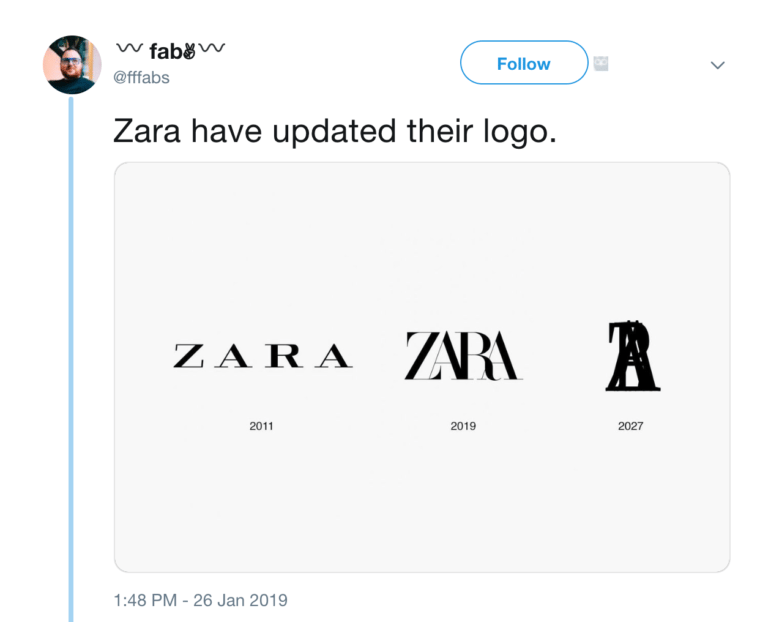
Companies may also be tempted to rebrand as a response to issues that require a different solution altogether. Low sales cycles, poor brand awareness, and dismal marketing results will only get worse with rebranding, according to Jon Simpson, a member of the Forbes Agency Council and owner of Criterion.B.
02. Research, Research, Research
Doing your due diligence by conducting research is the best insurance against a rebranding debacle. It begins with evaluating your current brand assets. How is your brand resonating (or not) with your customers, prospects, employees, and other stakeholders? Where are your competitors?
Question your assumptions and examine them against your research findings.
03. Get Buy-In
Don’t rebrand in a vacuum. Involve stakeholders from the get-go and throughout the entire rebranding process, through to post-launch. Collaboration, participation, and communication are all part of rebranding best practices.
“To get [rebranding] right from the start, a mix of ‘hands’ must be on deck, from top to bottom, inside and out,” says Anaezi Modu, founder and organizer of the Rebrand 100 Global Awards. It’s not something management can simply hand over to the marketing department and its consultants.
04. Invest in Implementation
As mentioned earlier, implementing the rebrand requires 20 times the budget of the conceptualization side of it. Take this into account when allocating your resources. Sometimes, the rebrand is sound, but it falls flat because not enough thought and energy was put into executing it.
05. Go Deeper Than Skin Deep
Even a superficial rebranding is a good occasion to re-examine your essence and culture, so you can more accurately express it.
“There is often a tendency to miss opportunities for real innovation and advancement,” Modu observes, “If you must, ask others to help reveal your blind spots. This prepares you to evolve and maintain relevance even as things change—which they inevitably do sooner or later.”
Rebranding: The Bottom Line
Rebranding can be the best thing that’s ever happened to a company… or it can be the worst.
What makes the difference?
Being true to your company’s identity and making it all about the customers you want to serve.
They can tell if you’re rebranding just for the sake of change or because you want to tell the story of who you have become.
Rebranding isn’t just about changing graphic designs; it’s about making inner transformation outwardly tangible.
If you’re looking to conceptualize, refresh, or update your business brand, read about what makes a small business brand successful.
In the meantime, what recent rebranding examples strengthened your connection with the brand? Which ones alienated you from the brand? Tell us in the comments below.



